May Day, Monday 1st May – Winster – A very unspringlike day! It was raining heavily throughout much of the night and the sky is full of leaden clouds promising more downpours. A brisk wind makes it rather chilly. Small fields contain sheep of various breeds and hues and cattle. Many of the dry stone walls have fallen and it seems clear they will not be resurrected. A Wheatear stands on a wall and then bobs off across the field flashing its “white-arse”, the origin of its name.
Wednesday 10th May – Barnsley Canal – Six in the morning and the sun is rising through a cloudless blue sky. Willowbank is a brilliant green. Bird song rings out from everywhere. A Sedge Warbler scratches out his tune from the Loop. Another is strangely silent at the top of a Hawthorn beyond the bridge. A Robin is still singing, as he has done since the beginning of the year. Willow Warblers flute their descending trill. A Blackcap is at the top of another Hawthorn by the bridge. There are Wrens everywhere – the winter may have been long, but it was clearly not cold enough to dent the Wren population. A Kestrel and Wood Pigeon share the top of a telegraph pole. The pigeon clearly does not see the Kestrel as a threat and the raptor does not see the other as a meal. Small whitish flower buds are appearing on both Hawthorn and Elder. A Dabchick dives in the canal at the base of Willowbank. Moorhens squawk from the reeds which are growing fast but are not yet high enough to attract a Reed Warbler.
Home – The recent rain and subsequent sunshine has brought the garden on rapidly. Potatoes are showing through. Broad beans are in flower. Lettuces are growing well. Apple blossom is dense on the greenhouse tree and on the pears, but not so advanced on the other apple trees.
Saturday 13th May – Barnsley Canal – A gentle drizzle turns into steady rain as Dill the Dog and I wander down the long slope of Willowbank. Everything is verdant – a bright, shiny greenness despite the grey clouds and misty view. A few Hawthorns are in flower; May blossom in May. Bird song carries on regardless of the weather. Blackbirds, Robins, Blackcaps, Willow Warblers, Wrens and Song Thrushes are all busy declaring their presence in their territories. There is even a Chiffchaff calling, although most have now fallen silent as they busy themselves with nest making. There is the merest glimpse of a Jay slipping silently away through the trees. The old fallen Willow that lies across the canal is looking magnificent as dozens of new trunks rise from the cracked and twisted trunk. A rather golden coloured Weasel is sitting upright on the tow-path. It bounds away into the undergrowth on our approach. The open hillside up to Greenfoot is covered by newly opening Buttercups. A Sky Lark sings overhead. A few Bluebells are scattered over the green sward. The rain becomes heavier and we are both dripping wet.
Wednesday 17th May – Barnsley Canal – Old Mill – The weather has been very changeable – sunshine, wind and rain. It is windy this afternoon and the air and the surface of the canal is full of tiny fluffy seeds from the willow trees. Japanese Knotweed is growing vigorously alongside the path. A Willow Warbler sings in the valley below. There has been a fire near the old lock. There have been a lot of fires set on Willowbank and it is worrying that the culprits will cause a major blaze soon.
Saturday 20th May – Fleets Dam – It is raining heavily and the River Dearne rushes over the weir. A Chiffchaff braves the wet conditions to sing on the other side of the river. Also on the far side, huge leaves of Giant Hogweed are unfolding. Leaves of Burdock and Hogweed are growing by the path and Cow Parsley is in flower. Red Campion is also blooming. Seven Great Crested Grebes and diving on the lake. At least three Grey Herons are present.
Saturday 27th May – Barnsley Canal, Dearne Valley Park – It is grey overhead with dark clouds on the horizon but, thankfully, it is not raining. It has been a wet week to say the least. It is also milder than of late. Hawthorns are covered in blossom – May. This is the blossom from which comes the expression “Ne’er cast a clout, ’til May is out”. A clout was an all-in-one undergarment that young children were sewn into in autumn and wore until the Spring. Cow Parsley in flowering in profusion. Large leaves of Burdock and Hogweed are well formed. Four drake Mallard are on the canal. A large fish glides into view under the water’s surface and drops away again. It is probably a carp. Chiffchaffs are calling near the bridge over the River Dearne. Down a steep path into the park. Blackbirds are searching the mown grass for food. A Whitethroat sings from the top of Hawthorns. Comfrey leaves stand erect. Buttercups are in flower. Down by the river there are numerous clumps of Japanese Knotweed. Surprisingly, there is a Reed Warbler singing from one clump. Willow Warblers are in song, one actually in a Willow. A pair of male Bullfinches fly off from the cinder path. Mute Swans are not nesting on the island in the small lake this year. A Roach swims just under the surface of the water. Back up to the canal where a large Goldfish is lurking by some waterweeds.
Sunday 28th May – Burton Bank – A parkland has been created out of some rough hillside rising eastwards from the river valley of the Dearne. The top of the hill is now all housing and just below here are the remains of extensive quarrying of the pale yellow sandstone, so prevalent in 19th century and early 20th century buildings in Barnsley. There is a wide view across the valley towards Barnsley town centre which rises from the opposite slope with the Town Hall on the brow of the ridge. The view is somewhat marred by the appalling Barnsley College buildings; concrete brutalism added to by a new building which looks like plastic brutalism. Behind the Town Hall is the boring high rise offices of John Riddeal House – the DSS, and the glass monolith that is being built to house Barnsley Council offices. Neither building has any architectural merit. Sadly, St Mary’s Church goes virtually unnoticed amidst these slabs of mediocrity. It is odd that after the dreadful concrete edifices put up in the sixties by Poulson, which are now to be demolished, that the Council and College cannot employ architects who have sympathy for the skyline of the town. A Whitethroat is singing in the young bushes below. Guelder Rose and Burnet Roses are flowering. There are a few signs of quarrying on the rock face at the top of the hill – a drill line here and a row of shallow grooves there. Feral Pigeons are nesting on a ledge. Dark clouds are building overhead.
Stainborough Castle – This magnificent house and gardens stand on a hill to the west of the M1 motorway on the site of an Iron Age hill fort. Stainborough Hall was built between 1727 and 1730 by Sir Thomas Wentworth, 1st Earl of Strafford (second creation). He had expected to inherit the estate at Wentworth Woodhouse, some 7 miles to the south of Stainborough, when the 2nd Earl of Strafford (first 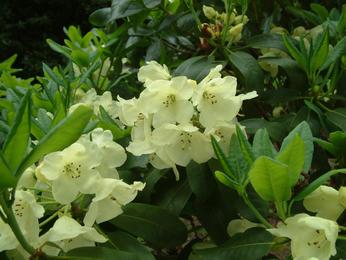 creation) died in 1695. Instead the estate was left to Thomas’ cousin. Bitter and resentful, Thomas secretly bought the neighbouring Stainborough estate in 1708 and began a major building programme. He then changed the name from Stainborough to Wentworth Castle, simply to annoy Wentworth Woodhouse. Dramatic gardens were laid out and the hill was topped by a mock castle, the second oldest Gothic garden folly in the country. The four towers were each named after the 1st Earl’s children, Harriet, Anne, Lucy and William, and the insides were each painted in a different colour. The folly is now in poor condition, but extensive restoration is underway. Likewise the house is also having major restoration work.
creation) died in 1695. Instead the estate was left to Thomas’ cousin. Bitter and resentful, Thomas secretly bought the neighbouring Stainborough estate in 1708 and began a major building programme. He then changed the name from Stainborough to Wentworth Castle, simply to annoy Wentworth Woodhouse. Dramatic gardens were laid out and the hill was topped by a mock castle, the second oldest Gothic garden folly in the country. The four towers were each named after the 1st Earl’s children, Harriet, Anne, Lucy and William, and the insides were each painted in a different colour. The folly is now in poor condition, but extensive restoration is underway. Likewise the house is also having major restoration work.
The gardens contain three National Plant Collections:- Rhododendrons, Magnolias and Camellias. Today, the gardens are open for the Rhododendron displays and they are magnificent. We walk up Lady Lucy’s walk, an avenue of common or European lime (Tilia x europaea) was planted in the 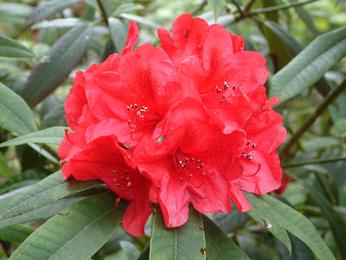 early 1920s. The avenue is known as “Lady Lucy’s Walk”, after one of the 1st Earl’s daughters. The story goes that she fell in love with one of the estate gardeners, but because of the big difference in their social ranking, was prevented from marrying him and eventually died of a broken heart. Her spirit is said to have a presence in the gardens. A path leads to the castle, but access is barred because of the restoration work. This is a good site for Pied Flycatchers and Hawfinches but I see no sign of either. Hopefully, the
early 1920s. The avenue is known as “Lady Lucy’s Walk”, after one of the 1st Earl’s daughters. The story goes that she fell in love with one of the estate gardeners, but because of the big difference in their social ranking, was prevented from marrying him and eventually died of a broken heart. Her spirit is said to have a presence in the gardens. A path leads to the castle, but access is barred because of the restoration work. This is a good site for Pied Flycatchers and Hawfinches but I see no sign of either. Hopefully, the 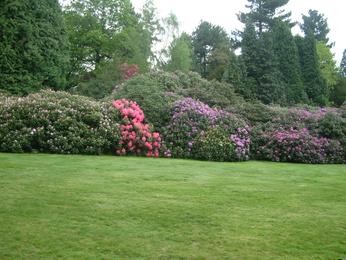 building work has not scared them off. A pair of Jays are on the trunk of one of the many pollarded trees; much work is being undertaken to clear out the old undergrowth and thin the trees. Nuthatches and Treecreepers are busy searching cracks and crevices in tree trunks. The path turns and leads into avenues of Rhododendrons – bright purples, pinks, reds and yellows against glossy dark green foliage. A Great Spotted Woodpecker flies over. In places, last night’s strong winds have dislodged hundreds and thousands of petals that lay on the ground like confetti after a wedding. A small enclosed garden of azaleas is a stunning display of bright oranges and yellows offset by a dark red Acer. The great glasshouse (featured in the BBC Restoration programme) is still sadly in a very poor state. It has been stabilised pending restoration but looks very sorry for itself at present.
building work has not scared them off. A pair of Jays are on the trunk of one of the many pollarded trees; much work is being undertaken to clear out the old undergrowth and thin the trees. Nuthatches and Treecreepers are busy searching cracks and crevices in tree trunks. The path turns and leads into avenues of Rhododendrons – bright purples, pinks, reds and yellows against glossy dark green foliage. A Great Spotted Woodpecker flies over. In places, last night’s strong winds have dislodged hundreds and thousands of petals that lay on the ground like confetti after a wedding. A small enclosed garden of azaleas is a stunning display of bright oranges and yellows offset by a dark red Acer. The great glasshouse (featured in the BBC Restoration programme) is still sadly in a very poor state. It has been stabilised pending restoration but looks very sorry for itself at present.
Bank Holiday Monday 29th May – Barnsley Canal – A Mistle Thrush flies to the top of the tallest Silver Birch on Willowbank and stands uneasily in the brisk northerly wind. The thrush displaces a Whitethroat that flies some distance away to begin its song again. A Jay flies down the hillside in its lumbering, undulating flight. A Reed Bunting flies across the canal. Further along the canal, a pair of Tufted Duck eye Dill the Dog uneasily. A Little Grebe dives. We climb up the buttercup spotted hillside and over the railway. A small flock of Long-tailed Tits move along the hedgerow. I sit a while in Wilthorpe Park. It is clear that many years ago much thought went into the planting of the trees. Weeping Willows, Copper Beeches, Cypress, Ash and Laburnum all compliment one another. Sadly, misuse and vandalism means the old pool at the bottom of the park has been filled in and the bowling greens are gone.
Cannon Hall – A walk along the stream and up into the gardens at Cannon Hall, the stately home, now a museum, was built by, possibly by John Etty of York in the early years of the 18th Century for John Spencer. There had been a building 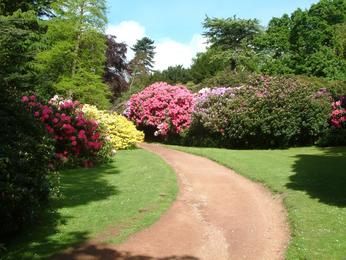 here which was recorded in the Domesday Book in 1086. The name comes from a 13th Century occupant of the site, Gilbert Canun. In the late 14th Century, Cannon Hall was owned by the Bosville family of Ardsley. The Bosvilles let the Hall to a family whose name is now unknown. The daughter of this family was romantically involved with a man called Lockwood, who had been involved in the murder of Sir John Eland, the Sheriff of the County. The tenant was afraid that he could find himself accommodating a fugitive, so he sent word to Bosville. Bosville’s
here which was recorded in the Domesday Book in 1086. The name comes from a 13th Century occupant of the site, Gilbert Canun. In the late 14th Century, Cannon Hall was owned by the Bosville family of Ardsley. The Bosvilles let the Hall to a family whose name is now unknown. The daughter of this family was romantically involved with a man called Lockwood, who had been involved in the murder of Sir John Eland, the Sheriff of the County. The tenant was afraid that he could find himself accommodating a fugitive, so he sent word to Bosville. Bosville’s 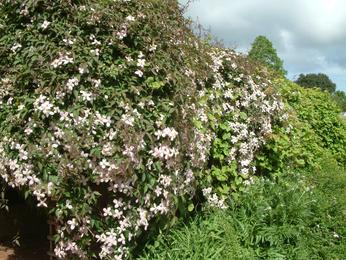 men arrived at Cannon Hall, where the fugitive was violently slain. In 1660, the estate was bought by John Spencer, a Welsh hay-rake maker, who had moved from the Welsh Borders which were an unsafe place for a Royalist like himself. He soon made a fortune from iron and coal and built the current hall. Seventy acres of parkland were landscaped in the 1760s by Richard Woods. A walled garden dates from the same period and contains over forty species of pear tree. There is also a two hundred year old vine in the greenhouse, a cutting of which was taken to Australia and formed the basis of today’s viniculture there. The gardens have an impressive display of Rhododendrons (although not in the same class as yesterday’s visit to Stainborough!) Numerous Canada Geese are on the lake and grass, some being followed by goslings of various ages.
men arrived at Cannon Hall, where the fugitive was violently slain. In 1660, the estate was bought by John Spencer, a Welsh hay-rake maker, who had moved from the Welsh Borders which were an unsafe place for a Royalist like himself. He soon made a fortune from iron and coal and built the current hall. Seventy acres of parkland were landscaped in the 1760s by Richard Woods. A walled garden dates from the same period and contains over forty species of pear tree. There is also a two hundred year old vine in the greenhouse, a cutting of which was taken to Australia and formed the basis of today’s viniculture there. The gardens have an impressive display of Rhododendrons (although not in the same class as yesterday’s visit to Stainborough!) Numerous Canada Geese are on the lake and grass, some being followed by goslings of various ages.